|
|
 |
|
Cyclopoida ( Order ) |
|
|
|
Oncaeidae ( Family ) |
|
|
|
Monothula ( Genus ) |
|
|
| |
Monothula subtilis (Giesbrecht, 1892) (F,M) | |
| | | | | | | Syn.: | Oncäa subtilis Giesbrecht, 1892 (p.591, 603, 774, Descr.F, figs.F);
Oncaea subtilis : Cleve, 1900 c (p.5, figs.M); Thompson & Scott, 1903 (p.239); Farran, 1908 b (p.92); Pesta, 1920 (p.652, fig.); Farran, 1926 (p.297); 1929 (p.210, 286); Campbell, 1929 (p.328, Rem.F); Rose, 1929 (p.58); 1933 a (p.300, figs.F); Shih & al., 1971 (p.157); Paulmier, 1971 (p.168); Björnberg, 1972 (p.92); Apostolopoulou, 1972 (p.329, 379); Razouls, 1972 (p.95, Annexe: p.115, figs.F); 1974 b (p.239, figs.F); Gallo, 1976 (p.276, Descr.M, figs.M); Malt, 1982 (p.193); 1982 a (p.134, figs. N, juv., F,M); 1983 a (p.7, figs.F,M, Rem.); Boxshall, 1998 (p.227); Heron & Frost, 2000 (p.1054, figs.F,M, tab.2); Conway, 2006 (p.23, copepodides 1-6, Rem.)
Ref. compl.: Cleve, 1904 a (p.194); Wilson, 1942 a (p.199); Sewell, 1948 (p.393, 461); Fagetti, 1962 (p.44); Shmeleva, 1963 (p.141); Björnberg, 1963 (p.80, Rem.); Unterüberbacher, 1964 (p.34); De Decker, 1964 (p.16, 23, 29); Northcote & al., 1964 (p.1069, Table II); Shmeleva, 1965 b (p.1350, lengths-volume -weight relation); Mazza, 1966 (p.73); Pavlova, 1966 (p.45); Vives & al., 1975 (p.56, tab.II, III); Peterson & Miller, 1976 (p.14, Table 1, 3, abundance vs interannual variations); 1977 (p.717, Table 1, seasonal occurrence); Dessier, 1979 (p.207); Gallo, 1981 (p.847, Rem.: p.849) Kovalev & Shmeleva, 1982 (p.85); Regner, 1985 (p.11, Rem.: p.41); Krsinic & Vilicic, 1989 (p.12, tab.3); Villate, 1991 a (fig.4); Böttger-Schnack, 1994 (p.277); 1995 (p.92); 1996 (p.1086); 1997 (p.409); Hure & Krsinic, 1998 (p.104); Krsinic, 1998 (p.1051); Siokou-Frangou, 1999 (p.479); Lopes & al., 1999 (p.215, tab.1); Vukanic, 2003 (p.139, tab.1); Valdés & al., 2007 (p.104: tab.1); Khelifi-Touhami & al., 2007 (p.327, Table 1); Cabal & al., 2008 (289, Table 1); Selifonova, 2011 (p.77, Table 1, alien species in Black Sea); Belmonte & al., 2013 (p.222, Table 2, abundance vs stations); Zaafa & al., 2014 (p.67, Table I, occurrence) | | | | Ref.: | | | Böttger-Schnack & Huys, 2001 (p.471, Redescr.F,M, Rem.); Böttger-Schnack & al., 2004 (p.1130, tab.1, Rem.); Vives & Shmeleva, 2010 (p.266, figs.F,M, Rem.); Böttger-Schnack & Machida, 2011 (p.111, Table 1, fig.2, DNA sequences, phylogeny); Böttger-Schnack & Schnack, 2013 (p.4: Table 1, p.12: Table 3) |  issued from : J.-M. Gallo in Vie Milieu, 1976, XXVI, 2A. [p.280, Fig.1]. Male (from La Pallice Harbor, NE Atlant.]. As Oncaea subtilis. Male: A, urosome (dorsal); B, A1; C, A2; D, Mx2; E, Mxp; F, P1; G, P2; H, P4; I, P3.
|
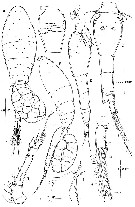 Issued from : R. Böttger-Schnack & R. Huys in Hydrobiologia, 2001, 453/454. [p.469, Fig.1]. Female: A, habitus (dorsal); B, idem (lateral left side, with egg-sac); C, urosome (dorsal); D, idem (lateral left side, ventro-anterior margin slightly damaged); E, genital double-somite (ventral); F, caudal ramus (dorsal; setae are numbered using Roman numerals); G, A1; H, P5 (dorsal); I, P6. Nota: Proportional lengths (%) of urosomites and caudal rami 7.4:36.7:16.9:15.3:12.8:10.9. Relative lengths (%) of segments of A1 measured along posterior non-setigerous margin 4.4:19.0:48.7:11.4:4.5:12.0. caudal ramus 2.2 times as long as wide [2.7:1 in specimens from the eastern mediterranean Sea]
|
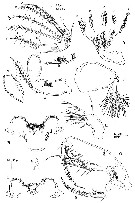 Issued from : R. Böttger-Schnack & R. Huys in Hydrobiologia, 2001, 453/454. [p.472, Fig.2]. Female: A, A2 (anterior; lateral elements are numbered using Roman numerals, distal elements numbered using capital letters [a, proximal endopod segment, posterior; b, outer margin of distal endopod segment, posterior]; B, labrum (anterior; arrows indicating secretory pores); C, idem (posterior); D, Md (showing individual elements, which are numbered using capital letter); E, Mx1; F, Mx2; G, Mxp (anterior) [g, claw, posterior, showing ornamentation along outer margin].
|
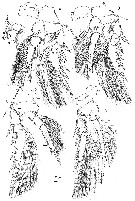 Issued from : R. Böttger-Schnack & R. Huys in Hydrobiologia, 2001, 453/454. [p.473, Fig.3]. Female: A, P1 (posterior) [a, first 2 endopod segments and inner part of basis, arrow indicating ornamentation of endopod-2]; B, P2 (posterior); C, P3 (anterior), intercoxal sclerite partly omitted); D, P4 (anterior). Arrows in B-D indicating pore on inner of endopod-3.
|
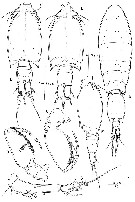 Issued from : R. Böttger-Schnack & R. Huys in Hydrobiologia, 2001, 453/454. [p.476, Fig.4]. Male: A, habitus (dorsal); B, Mxp (anterior); C, idem (posterior); D, urosome (dorsal, spermatophores well developed); E, idem (ventral); F, idem (latera lleft side); G, A1. Nota: Proportional lengths (%) of urosomites and caudal rami 8.1:51.6:3.7:3.7:4.5:14.6:13.8. Relative lengths (%) of segments of A1 measured along posterior non-setigerous margin 5.3:20.0:47.0:27.7.
|
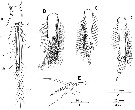 Issued from : R. Böttger-Schnack & R. Huys in Hydrobiologia, 2001, 453/454. [p.477, Fig.5]. Male: A, caudal ramus (dorsal); setae are numbered using Roman numerals, dorsal seta VII omitted); B, P1 (endopod-3, anterior); C, P2 (endopod-3, posterior); D, P3 (endopod -3, anterior); E, P5 (dorsal).
|
 issued from : G.A. Heron & B.W. Frost in Proc. Biol. Soc. Washington, 2000, 113 (4). [p.1053, Fig.21, F-K]. As Oncaea subtilis. Female (from Washington Inland waters): F-G, habitus (dorsal and lateral, respectively; scale bar: w); H, right A2 (scale bar: z); I, labrum (scale bar: y); J, right Md (scale bar: y); K, left Mx1 (scale bar: y). Scale bars: 0.1 mm, see figures 3, 4, 5, 10 of Heron and Frost, 2000 for Oncaea canadensis and Oncaea insolita.
|
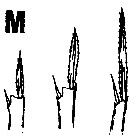 issued from : G.A. Heron & B.W. Frost in Proc. Biol. Soc. Washington, 2000, 113 (4). [p.1022, Fig.2, M]. As Oncaea subtilis. Female: P2-P4 endopod terminal ''spine set'' (combination of the lengths, shapes, and position of the three or two terminal spines on the endopods of swimming legs 2-4 , from left to right in figure, for different Oncaea' species). Nota: endopod of P3 with terminal spine shorter than length of segment. Endopod of P4 with subterminal spine about 1/3 the length of terminal spine.
|
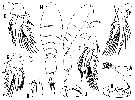 issued from : G.A. Heron & B.W. Frost in Proc. Biol. Soc. Washington, 2000, 113 (4). [p.1055, Fig.22]. As Oncaea subtilisFemale: A, left Mx2 (scale bar: z); B, right Mxp (scale bar: x); C-F, P1 to P4 (scale bar: x); G, pediger 4 posterior corner and segment of P5 (scale bar: x). Male: H-I, habitus (dorsal and lateral, respectively; scale bar: s); J, right Mxp (scale bar: x).
|
 Issued from : W. Giesbrecht in Systematik und Faunistik der Pelagischen Copepoden des Golfes von Neapel und der angrenzenden Meeres-Abschnitte. – Fauna Flora Golf. Neapel, 1892, 19 , Atlas von 54 Tafeln. [Taf.47, Fig.14]. As Oncäa subtilis. Female: 14, habitus (dorsal).
|
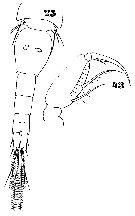 Issued from : W. Giesbrecht in Systematik und Faunistik der Pelagischen Copepoden des Golfes von Neapel und der angrenzenden Meeres-Abschnitte. – Fauna Flora Golf. Neapel, 1892, 19 , Atlas von 54 Tafeln. [Taf.47, Figs.25, 43]. As Oncäa subtilis. Female: 25, urosome (dorsal); 43, Mxp.
|
 Issued from : W. Giesbrecht in Systematik und Faunistik der Pelagischen Copepoden des Golfes von Neapel und der angrenzenden Meeres-Abschnitte. – Fauna Flora Golf. Neapel, 1892, 19 , Atlas von 54 Tafeln. [Taf.47, Fig.18]. As Oncäa subtilis. Female: 18, A2.
|
 Issued from : W. Giesbrecht in Systematik und Faunistik der Pelagischen Copepoden des Golfes von Neapel und der angrenzenden Meeres-Abschnitte. – Fauna Flora Golf. Neapel, 1892, 19 , Atlas von 54 Tafeln. [Taf.47, Fig.60]. As Oncäa subtilis. Female: 60, P4 (posterior view).
|
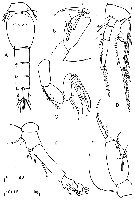 issued from : C. Razouls in Th. Doc. Etat Fac. Sc. Paris VI, 1972, Annexe. [Fig.74]. As Oncaea subtilis. Female (from Banyuls, G. of Lion): A, urosome; B, F, Mxp; C, A2; D, P4; E, A1.
| | | | | Compl. Ref.: | | | Krsinic & Grbec, 2002 (p.127, tab.1); Rawlinson & al., 2005 (p.205, tidal exchange); Krsinic & al., 2007 (p.528); Rossi, 2008 (p.90: Tableau XII); Miyashita & al., 2009 (p.815, Tabl.II); Böttger-Schnack & Schnack, 2009 (p.131, Table 3, 4); Mazzocchi & Di Capua, 2010 (p.429); Shiganova & al., 2012 (p.61, Table 4); Uysal & Shmeleva, 2012 (p.909, Table I); Vidjak & al., 2012 (p.243, Rem.: p.253); Krsinic & Grbec, 2012 (p.57, 63: abundance); Gubanova & al., 2013 (in press, p.4, Table 2); Zakaria & al., 2016 (p.1, Table 1); Vidjak & al., 2016 (p.629, Rem.); Benedetti & al., 2016 (p.159, Table I, fig.1, functional characters); Benedetti & al., 2018 (p.1, Fig.2: ecological functional group); Chaouadi & Hafferssas, 2018 (p.913, Table II: occurrence). | | | | NZ: | 13 | | |
|
Distribution map of Monothula subtilis by geographical zones
|
| | | | | | | | | | | | | Loc: | | | South Africa (E & W), Namibia, Congo, off Mauritania, Canary Is., off Madeira, Azores, Brazil (S, Rio de Janeiro), Caribbean Sea, Bay of Biscay, La Pallice roadstead, Belon estuary, off Irlande W, Lough Hyne, Faroe Channel, Skagerrak, North Sea, Gibraltar W, Medit. (M'Diq, Alboran Sea, Habibas Is., El Kala shelf, Balearic Basin, Banyuls, Toulon Harbour, Ligurian Sea, Napoli, Gulf of Taranto, Taranto Harbour, Adriatic Sea, Sibenik Harbour, Aegean Sea, Black Sea, W Egyptian coast, Lebanon Basin), Red Sea, Strait of Bab al Mandab, Arabian Sea, SW Indian, Japan (Honshu), NE Pacif., Vancouver Is., Nitinat Lake, Washington inland, Oregon (off Newport), Pacif. (E tropical), off Chile | | | | N: | 72 ? | | | | Lg.: | | | (46) F: 0,5-0,48; (141) F: 0,5-0,48; (237) F: 0,5; M: 0,4; (432) F: 0,6-0,45; (449) F: 0,5-0,48; (692) F: 0,69-0,46; M: 0,44-0,38; (786) F: 0,59-0,58; (877) F: 0,44-0,52; M: 0,34-0,38; {F: 0,44-0,69; M: 0,34-0,44} | | | | Rem.: | epi-mesopelagic.
After Björnberg (1963, p.80) this species is found for the first time in the South Atlantic. It occurs in swarms chiefly in deep coastal waters and in shelf waters. In more saline waters it was registered in lower temperatures (22°C or less).
For Böttger-Schnack & Huys (2001, p.478) this species is most closely related to Oncaea curvata; it can be distinguished from its sistertaxon O. curvata mainly by (1) loss of the outer subdistal spine on P2-P4 endopod-3; (2) nature of outer exopodal seta on P5, being strong and spiniform (while this seta is slender and setiform in O. curvata; and (3) presence of an unpaired median dorsal egg-sac; and other minor differences.
After Benedetti & al. (2018, p.1, Fig.2) this species belonging to the functional group 5 corresponding to small sac-spawning detritivorous. | | | Last update : 28/02/2020 | |
|
|
 Any use of this site for a publication will be mentioned with the following reference : Any use of this site for a publication will be mentioned with the following reference :
Razouls C., Desreumaux N., Kouwenberg J. and de Bovée F., 2005-2025. - Biodiversity of Marine Planktonic Copepods (morphology, geographical distribution and biological data). Sorbonne University, CNRS. Available at http://copepodes.obs-banyuls.fr/en [Accessed August 17, 2025] © copyright 2005-2025 Sorbonne University, CNRS
|
|
 |
 |

















